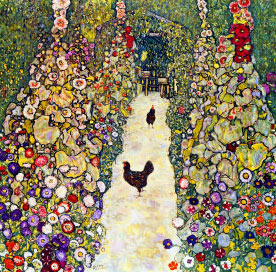Garden Path with Hens
The artwork, Garden Path With Hens, gently intertwines an impressionist and modern technique to present a bright array of colours accompanied by a linear form. A fire destroyed the beautiful painting in 1945, by German Armed Forced who had seized an array of Klimt's work. The painting is part of an array the artist completed during the summer of 1916, as he spent his summer at his traditional spot over Lake Attersee.
The piece was created during the midst of World War One, while the artist was seized with his work rather than the political and economic turmoil that filled the nation. Klimt's escape from the city into the countryside allowed the artist to focus on his work, near the end of his career.
Klimt steered away from his traditional neopontillistic style used through his landscape painting, which blurred the objects together, to a more structured style that illustrated the natural forms. The piece showcases an array of positive colour through the bushes of flowers located around the sides. These wonderful flowers are grown to immense heights and covered with different types of blossoms.
Near the bottom of the arrangement, purple coloured flowers fill the canvas, gently blending out towards white coloured ones. Around these two shades, small red glowers fill the scene with yellow middles. Klimt adored the trio colour scheme of purple, yellow and a warm shaded colour for his flowers. These three together created a simple mosaic pattern that dominates the artist's work.
Large flat tropical leaves fill the ensemble, paired with light pink peonies towards the top. At the highest point of the arrangement, deep blood red flowers act as the central mark. The way in which the flowers intertwine with one another adds structure and patterns to the piece. Around the outside of the bushes, the canvas transforms into vegetation, using shades of blue and green to show the tops of trees. A yellow and white stoned path is located near the middle of the painting, elongating the piece as it leads towards a small area in the end. At the end of the painting seems to stand a small wooden bench and stool, under a blue coloured roof.
The interesting component of the piece is the two hens located in the middle of the canvas. These rich brown hens straddle with their dark features and glimpse of red, adding curiosity towards the piece. Klimt had incorporated hens and chickens into his work previously in After The Rain (1899), which manifests a calm meadow accompanied by a dozen chickens. Klimt's classic mosaic style transforms the flowers bushes within the piece, lightly paired with the impressionism hens in the middle of the piece.




